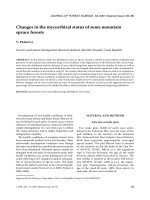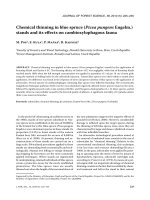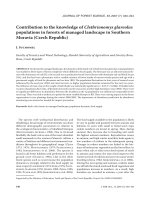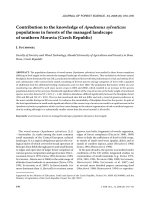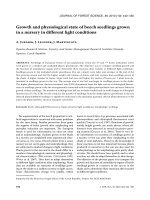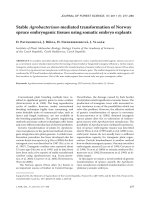Báo cáo lâm nghiệp: "Findings from the application of coal combustion by-products (CCB) for forest reclamation on spoil banks of the North Bohemian Brown Coal Basin" pdf
Bạn đang xem bản rút gọn của tài liệu. Xem và tải ngay bản đầy đủ của tài liệu tại đây (767.97 KB, 8 trang )
J. FOR. SCI., 55, 2009 (3): 137–144 137
JOURNAL OF FOREST SCIENCE, 55, 2009 (3): 137–144
Texturally heterogeneous substrates of the already
coal seam with adverse chemical and physical prop-
erties of soil also belong to the important category
of stripped overburden rocks during the open-cast
mining of brown coal in the North Bohemian Ba-
sin that are deposited on above-level dumps and
reclaimed for forestry purposes. Loess loams, re-
moval of low-quality humus horizons, marls and
marlstones are used the most frequently to improve
their soil properties while bentonites were also ap-
plied for these purposes in the past (O et
al. 2003; Ř et al. 2006). After 1990, wastes of
different organic origin were used on a larger scale
for these purposes (Č, K 1995) in con-
nection with the attenuation of agriculture in the
region concerned; in 2000 available coal combustion
by-products (stabilizate, FDG gypsum) generated
by the Ledvice thermal power station were included
in the programme of testing other amendments in
the Bílina Mine locality. is treated power-station
fly ash is used the most frequently as certified pro-
ducts in the building industry or it is deposited as
waste at dumpsites in dry state. Greater experience
with the use of this treated power-station fly ash
for the improvement of chemical and physical soil
properties of spoil bank soils has been missing until
Supported by the Ministry of Agriculture of the Czech Republic, Project No. MZE 0002704901.
Findings from the application of coal combustion
by-products (CCB) for forest reclamation on spoil
banks of the North Bohemian Brown Coal Basin
P. Č
1
, V. O
2
1
Research Institute for Soil and Water Conservation, Prague, Czech Republic
2
North Bohemian Mines, a. s., Chomutov, Czech Republic
ABSTRACT: Coal combustion by-products (stabilizate, FDG gypsum) generated by the thermal power station in
Ledvice were tested on an above-level dump of the Bílina Mine in the North Bohemian Brown Coal Basin during the
reclamation of its surface for forestry purposes. A part of the experimental object was treated with coal combustion by-
products at a dose of 700–1,000 t/ha that were incorporated into the soil profile by very deep ploughing and the other
part was left untreated for comparison. A one-year preparatory agrocycle was conducted on the entire experimental
object – growing of Leucosinapis alba for green manuring and for reforestation bareroot and container-grown planting
material was set out into dug holes [Larix decidua L., Pinus nigra Arn., Pinus sylvestris L., Quercus robur L., Carpinus
betulus L., Acer pseudoplatanus L., Acer platanoides L., Alnus glutinosa (L.) Gaertn., Fraxinus excelsior L., Tilia cor-
data Mill., Betula verrucosa Ehrh.]. e assessment of the experimental object at the age of 7 years indicated that as a
result of the application of stabilizate and FDG gypsum there was an increase in porosity, water-retaining capacity, soil
alkalinity and carbonate content; the soil-forming process was characterized by a decrease in soil alkalinity whereas
the high alkalinity of the soil horizon treated with this amendment did not negatively influence the growth vitality of
most tree species taxa used for reforestation.
Keywords: spoil bank Anthroposols; forest reclamation; coal combustion by-products; soil properties; growth vitality; root
system
138 J. FOR. SCI., 55, 2009 (3): 137–144
now whereas an alternative is the knowledge of the
adjustment of soil properties of spoil bank soils for
forestry purposes by means of other amendments
(Š 1982; K et al. 1998; S et al.
1999; W et al. 1999).
MATERIAL AND METHODS
Establishment of experimental plot: the plot 2.8 ha
in size with tested coal combustion by-products (CCB)
is situated on a flatland and on adjacent south-eastern
slope of the inner spoil bank of Bílina Mine (Fig. 1).
e area belongs to the warm and dry climatic region
(T1) with average annual temperature 8–9°C, aver-
age annual precipitation amount below 500 mm and
vegetation precipitation amount below 310 mm, and
40–50% probability of the occurrence of dry growing
seasons. Heterogeneous overburden rocks (grey clays,
clayey sands, admixture of coal and porcelanites) were
dumped onto the spoil bank surface.
In the framework of technical reclamation the
entire plot was overlaid with a topsoil stratum 0.2 to
0.35 m in thickness; about a half of the plot was
applied the stabilizate (a mixture of fly ash treated
with 1–2% CaO, 25% water, slag and FDG gypsum)
and FDG gypsum (dihydrate of calcium sulphate
– a product of flue gas scrubbing by wet limestone
washing) at an amount of 700–1,000 t/ha, which was
incorporated into the soil profile by repeated and
very deep ploughing. A one-year agrocycle with the
growing of Leucosinapis alba for green manuring
was realized on the entire experimental plot; the crop
was cut in the stage of flowering and incorporated
into the soil profile by disking. In autumn 2000 and
in spring 2001 the plot after such a reclamation was
reforested with bareroot planting material 2/0–3/0
[Quercus robur L., Carpinus betulus L., Acer pseu-
doplatanus L., Acer platanoides L., Alnus glutinosa
(L.) Gaertn., Fraxinus excelsior L., Tilia cordata Mill.,
Betula verrucosa Ehrh.] and with container-grown
planting material 2/1 (Pinus sylvestris L., Pinus nigra
Arn., Larix decidua L.) set out at a 1 × 1.5 m spacing
into dug holes 0.3 × 0.3 m in size.
Assessment of soil properties of Anthroposols and
growth vitality of the forest tree species plants: the
assessment of texture, chemical and other soil proper-
ties of Anthroposols was done on the basis of collec-
tions and laboratory analyses of disturbed soil samples
taken from characteristic soil horizons (spoil bank
soils, topsoils, topsoils influenced by the ploughing-
in of CCB) at 3 replications in each assessed state of
reclamation (“A”, “B”). To determine the characteristics
of soil reaction and carbonate content the number of
collections and analyses in the soil horizon influenced
by CCB ploughing-in was increased to 15. ese pa-
rameters were determined in disturbed soil samples:
texture (Novák), exchange soil reaction, content of
carbonates, total nitrogen and organic matters, sorp-
tion properties and content of available nutrients – P,
K, Mg, Ca (Mehlich III). Physical soil properties were
determined on the basis of collections and analyses
of 10 undisturbed soil samples (Kopecký΄s cylinders
100 cm
3
in volume) from the same soil horizons and
assessed states of reclamation as in disturbed samples.
Maximum capillary suction, maximum capillary water
capacity, porosity and volume weight were determined
in undisturbed soil samples.
Fig. 1. A general view of the experimental plot, the treatment
with the application of CCB is on the left
Fig. 2. Acer platanoides L. in the treatment with the appli-
cation of CCB
J. FOR. SCI., 55, 2009 (3): 137–144 139
e growth vitality of the forest tree species plants
was assessed by determining total height after 7 years
of development when 20–50 individuals (in rela-
tion to the frequency of their representation in the
stand composition) from each taxon used for the
reforestation of the state of reclamation “A” and “B”
Fig. 3. Fraxinus excelsior L. in the treatment with the
application of CCB
Fig. 4. Populus tremula L. in the treatment with the application
of CCB
Fig. 5. Tilia cordata Mill. and Pinus nigra Arn. in the treatment
with the application of CCB
Fig. 6. Deformations of the root system in the used
containerized plant material of Pinus sylvestris L.
140 J. FOR. SCI., 55, 2009 (3): 137–144
were evaluated. One-factor ANOVA was used for the
analysis of the growth data. With respect to the ap-
plied amendment (CCB) the evaluation of the growth
vitality of forest tree species plants at the evaluated
age also comprised the nutrient status of assimila-
tory organs (P, K, Ca, Mg, N) including the content
of hazardous elements (As, Be, Cd, Cr, Cu, Mn, Ni, V,
Pb, Zn, Hg) on the basis of collections and analyses
of leaf (needle) samples of different tree species taxa
from the assessed state of reclamation “A” and “B”. e
methodical procedure of the analysis of leaf biomass
consists in its mineralization with nitric and perchlo-
ric acid, followed by determination of metals with an
AAS – VARIAN 240 apparatus; phosphorus is deter-
mined with a SKALAR flow automatic analyzer.
RESULTS AND DISCUSSION
Pedological characteristics of Anthroposol im-
proved by CCB: the soil horizon (0–0.1 m) formed
of topsoil and not influenced by the applied CCB
represents clay-loamy soil in terms of texture that is
characterized by high water-retaining capacity and
medium porosity. Soil reaction is neutral to weakly
alkaline, the soil is slightly calcareous, with a me-
dium content of organic matters, full sorption, and
medium cation exchange capacity; as for the avail-
able nutrients the content of phosphorus is low, that
of potassium is high to very high, of magnesium very
high and calcium content is good to high. As a result
of CCB ploughing-in into the soil horizon formed of
topsoil (pedological characteristics of soil horizon
0.1–0.35 m) the content of soil particles < 0.01 mm
decreased below the limit 45% (already loamy soil),
maximum capillary water capacity and porosity in-
creased, soil alkalinity increased by up to 3°, carbon-
ate content rose by up to 12% and calcium reserve
increased by up to 35,000 mg/kg. Unimportant soil
changes as a result of CCB application were observed
in the content of organic matters and total nitrogen,
degree of base cation saturation, content of phospho-
rus and potassium. On the contrary, cation exchange
capacity and magnesium content decreased as a re-
sult of CCB application. e soil-forming process of
the soil horizon influenced by CCB ploughing-in is
characterized at the age of 7 years by an invariability
of the achieved initial state of improvement of physi-
cal soil properties (water-retaining capacity, poros-
ity) and by a decrease in soil alkalinity and carbonate
content. Tables 1 and 2 show the soil properties of
evaluated Anthroposols.
Growth vitality of evaluated taxa of forest tree
species: generally, irrespective of the evaluated rec-
lamation treatments (“A”, “B”), the highest losses as a
Table 1. Chemical and other soil properties
Reclamation
treatment
Soil horizon
(cm)
pH KCl
CaCO
3
(%)
N
tot
(%)
C
ox
(%)
CEC
(cmol
+
/kg)
Available nutrients (mg/kg)
P K Mg Ca
2001
“A”
0–10 6.9–7.3 0.3–0.9 0.09–0.13 1.1–1.3 15.2–21.7 6–8 175–396 774–810 3,950–4,370
10–35
8.2–9.5 4–13 0.05–0.07 1.0–1.2 7.5–15.7 7–9 277–464 510–516 26,325–39,665
> 40 4.3–7.2 < 0.1 < 0.05 0.5–3.2 5.8–17.1 < 1 148–261 564–1,015 2,458–2,737
“B”
0–20 6.8–7.2 0.1–0.9 0.08–0.11 0.9–1.5 13.5–20.8 5–7 202–440 510–690 3,440–4,125
> 40 5.1–7.2 < 0.1 < 0.05 0.1–0.9 5.0–15.7 1–7 136–264 327–540 1,471–2,404
2007
“A” 10–35 7.7–7.9 5–11 0.05–0.1 0.7–1.2 5.0–13.8 4–6 344–574 433–618 31,393–42,991
Explanations to Tables 1 and 2: treatment “A” (0–10 cm = humus horizon not significantly influenced by the stabilizate, 10–35 cm = horizon significantly influenced by the stabilizate,
> 40 cm = spoil bank soil), treatment “B” (0–20 cm = humus horizon, > 40 cm spoil bank soil)
J. FOR. SCI., 55, 2009 (3): 137–144 141
result of plant mortality in the first year after refor-
estation were identically recorded in Quercus rubra
L. (90–100%), Larix decidua L., Betula verrucosa
Ehrh
. and Alnus glutinosa (L.) Gaertn. (30–50%),
Fraxinus excelsior L., Quercus robur L., Carpinus
betulus L., Acer platanoides L., Acer pseudoplatanus
Table 2. Physical soil properties (2000)
Reclamation
treatment
Soil horizon
(cm)
Maximum capillary
soil suction (% by
vol.)
Maximum capillary
moisture capacity
(% by vol.)
Porosity
(%)
Bulk density
(g/cm
3
)
2001
“A”
0–10 45–53 32–36 49–58 1.1–1.4
10–35 65–69 47–50 63–68 0.9–1.0
> 40 35–42 33–39 36–42 1.6–1.7
“B”
0–20 47–54 32–37 49–59 1.1–1.3
> 40 38–41 35–37 36–42 1.5–1.7
2007
“A” 10–35 61–67 44–51 59–69 0.8 – 1.1
Table 3. Characteristics of forest tree species development
Tree species
Reclamation
state
Total height of seedlings
(cm), 2001
Total height of
seedlings (cm),
2007, average
Value P Value F Difference
dispersion average
Larix decidua L.
“A” 43–81 55 236
0.052 4.07 conclusive
“B” 34–84 59 264
Pinus nigra Arn.
“A” 23–36 29 190
0.306 1.08 inconclusive
“B” 23–44 36 178
Pinus sylvestris L.
“A” 24–38 30 269
0.154 2.11 inconclusive
“B” 35–54 44 248
Quercus robur L.
“A” 48–96 70 191
0.123 2.48 inconclusive
“B” 61–102 80 213
Carpinus betulus L.
“A” 27–61 39 181
0.243 1.40 inconclusive
“B” 24–59 42 168
Acer pseudoplatanus L.
“A” 49–101 69 256
0.012 6.93 conclusive
“B” 71–95 94 293
Acer platanoides L.
“A” 55–89 69 402
0.010 7.28 conclusive
“B” 61–112 76 332
Alnus glutinosa (L.)
Gaertn.
“A” 39–93 71 305
0.297 1.12 inconclusive
“B” 46–101 86 291
Fraxinus excelsior L.
“A” 46–80 66 286
0.188 1.79 inconclusive
“B” 43–65 49 263
Tilia cordata Mill.
“A” 20–59 44 187
0.784 0.08 inconclusive
“B” 33–68 43 184
Betula verrucosa Ehrh.
“A” 35–78 49 361
0.317 1.03 inconclusive
“B” 52–96 59 342
F
crit.
= 4.098, α = 0.05
142 J. FOR. SCI., 55, 2009 (3): 137–144
Table 4. Contents of basic and hazardous elements in assimilatory tissues of the tree species (2007)
Tree species
Content (% dry matter) Content (mg/kg)
Ash P Ca Mg K N As Be Cd Cr Cu Mn Ni V Pb Zn Hg
Treatment “A”
Pinus sylvestris L. 3.26 0.15 0.20 0.11 1.08 1.29 0.04 0.005 0.02 1.04 2.85 12.3 0.21 0.30 0.10 34.6 0.010
Betula verrucosa Ehrh. 5.02 0.15 0.31 0.12 0.84 1.24 0.04 0.005 0.02 0.38 1.43 11.8 0.20 0.50 0.15 32.6 0.009
Alnus glutinosa (L.) Gaertn. 8.72 0.17 1.38 0.29 1.21 2.79 0.10 0.018 0.03 1.96 2.73 40.2 0.66 1.10 0.30 27.7 0.022
Acer platanoides L. 12.69 0.31 2.23 0.41 1.52 2.25 0.09 0.010 0.01 1.29 6.26 18.6 1.13 0.80 0.20 15.1 0.023
Tilia cordata Mill. 12.50 0.20 1.68 0.28 1.74 2.59 0.05 0.009 0.02 1.13 5.10 27.8 0.52 0.70 0.15 24.5 0.018
Fraxinus excelsior L. 12.02 0.30 1.68 0.28 1.26 2.02 0.10 0.016 0.05 1.19 3.05 37.6 0.69 1.30 0.40 34.4 0.026
Treatment “B”
Pinus sylvestris L. 3.21 0.15 0.18 0.12 0.94 1.38 0.03 0.009 0.02 3.52 3.19 11.8 0.55 0.30 0.10 34.7 0.011
Betula verrucosa Ehrh. 2.98 0.16 0.26 0.12 0.86 1.50 0.02 0.013 0.08 0.60 2.94 11.0 0.35 0.30 0.10 38.4 0.011
Alnus glutinosa (L.) Gaertn. 9.09 0.18 1.28 0.30 1.10 2.89 0.08 0.017 0.03 1.83 3.01 41.6 0.87 1.20 0.40 29.0 0.027
Acer platanoides L. 12.49 0.25 2.28 0.49 1.52 1.96 0.07 0.010 0.01 2.02 5.28 19.0 1.05 0.80 0.25 16.3 0.024
Tilia cordata Mill. 9.30 0.21 1.65 0.30 1.53 1.92 0.06 0.010 0.02 0.91 2.18 24.2 0.45 0.60 0.24 17.9 0.020
Fraxinus excelsior L. 10.18 0.17 1.09 0.30 1.15 2.65 0.08 0.022 0.01 2.30 5.44 39.9 0.55 1.60 0.48 34.3 0.017
J. FOR. SCI., 55, 2009 (3): 137–144 143
L. and Tilia cordata Mill. (2–15%) whereas the used
containerized planting material of Pinus sylvestris
L. and Pinus nigra Arn. was characterized by prac-
tically no mortality (max. 1%). e majority of the
evaluated tree species taxa showed the identical
growth prosperity, regardless of different reclama-
tion treatment (“A”, “B”). e tallest stand height af-
ter seven years of development was reached by Acer
platanoides L. (Fig. 2), Betula verrucosa Ehrh., Fraxi-
nus excelsior L. (Fig. 3) and among the other un-
mentioned taxa also by Populus tremula L. (Fig. 4);
the smallest stand height was recorded in Pinus
nigra Arn. and Tilia cordata Mill. (Fig. 5), Carpinus
betulus L. and Quercus robur L. Some observed dif-
ferences in recorded heights (Table 3) in the evalu-
ated reclamation treatments may be influenced by
other important site factors; in the evaluated area it
is the heterogeneity of the soil profile influenced by
spoil bank earth, thickness of the overlaying topsoil
stratum, state of the mixing of CCB with topsoil
including the water regime (slope, flatland) that con-
tinues to change as a result of the building of other
storeys of the spoil bank body. e taxa responding
to different reclamation treatments (“A”, “B”) in a
significant manner are particularly Acer platanoides
L., which shows better growth prosperity at the site
with stabilizate, and Acer pseudoplatanus L., which
however prospers better in the treatment without
stabilizate. Problematic are some growth differences
detected in Pinus sylvestris L., Pinus nigra Arn.
and Larix decidua L. As a consequence of the qua-
lity of containerized planting material permanent
developmental deformations were observed in up
to 80% of evaluated individuals – flat, one-sided,
spiral-coiled root system, root penetration of the
soil profile max. to a depth of 0.4 m (Fig. 6), while
the stems of these tree species frequently suffer from
attrition damage caused by the wild boar. On chemi-
cally abnormal soils, among which Anthroposols are
very often classified, mainly the natural selection of
forest tree species takes place that are able to adapt
themselves in the best way to the given environ-
ment, having the capacity to absorb a large amount
of “specific” elements. e chemical analysis of their
organs allows the phytogeochemical determination
of significances in nutrition realized in connection
with the soil conditions created by reclamation.
Based on the performed leaf analyses the deter-
mined differences in element contents between the
evaluated reclamation variants “A” and “B” can be
considered as insignificant. B (1994) reported
the following contents of basic and trace elements
in natural soils in broadleaved tree species: N 1.7 to
4.0%, P 0.15–0.30%, K 1.0–1.8%, Ca 0.2–1.5%, Mg
0.15–0.40%, Mo 0.05–0.26 mg/kg, Cu 5–12 mg/kg,
Mn 30–100 mg/kg, Zn 15–50 mg/kg and in conifers:
N 1.1–2.5%, P 0.11–0.35%, K 0.4–2.0%, Ca 0.2–1.2%,
Mg 0.1–0.4%, Mo 0.01–0.40 mg/kg, Cu 2–12 mg/kg,
Mn 35–500 mg/kg, Zn 15–100 mg/kg.
CONCLUSION
e used technology of incorporation of coal com-
bustion by-products CCB into the soil profile, also by
several ploughing operations, including subsequent
treatment of soil by disking for the growing of a crop
for green manuring, is a condition for the profile
formation of Anthroposol with the chemically and
physically largely heterogeneous soil environment.
To achieve the appropriate reclamation state in the
improvement of soil properties by CCB will require
the use of means of mechanization operating as ho-
mogenizers – rotary tillers that can perfectly work
the soil profile 0.4–0.5 m in thickness.
e knowledge of the CCB application in con-
ditions of Anthroposols of the Bílina Mine was
acquired in a pedologically relatively luxurious en-
vironment represented by the overlaying of the spoil
bank surface with stripped humus horizon – humic
Anthroposol (N 2001) designed rather for
agricultural purposes and where this reclamation
measure is of experimental character and can be
considered as above standard from practical aspects.
is technology of improvement of soil properties
will be of substantially greater reclamation impor-
tance in conditions of lighter-textured spoil bank
soils with frequent admixture of substrates of the
already coal seam where the complex character
of the improvement of soil properties becomes a
priority requirement, and this technology will be
applicable in texturally similar conditions of natural
forest soils as a replacement of various calcareous
fertilizers and important amendment applicable for
the improvement of some physical soil properties
(water-retention capacity, porosity). An amount of
500–1,000 t/ha can be recommended as a suitable
dose of CCB with a longer-term effect on the ad-
justment of the soil profile 0.3–0.4 m in thickness
(in relation to the soil reaction of improved soil and
CaO content in CCB).
Interesting are also data on the growth prosperity
of the initial development of the tested assortment
of forest tree species in the environment of high soil
alkalinity. e influence of this factor was not signifi-
cant either on the survival rate or on development
during 7 years, and it was interesting mainly in Alnus
glutinosa (L.) Gaertn., Fraxinus excelsior L., Pinus
sylvestris L. and Betula verrucosa Ehrh.
144 J. FOR. SCI., 55, 2009 (3): 137–144
Refer ences
BENEŠ S., 1994. Obsahy a bilance prvků ve sférách životního
prostředí. II. část. Praha, MZe ČR: 159.
ČERMÁK P., KURÁŽ V., 1995. Protierozní stabilizace výsyp
-
kových zemin pomocí organických substrátů. Rostlinná
výroba, 41: 475–479.
KATZUR J., BÖCKER L., STÄHR F., MERTZIG C.C., 1998.
Zu den Auswirkungen der Meliorationstiefe auf das Wald-
wachstum der Kippen – Erstaufforstungen. Beiträge für
Forstwirtschaft und Landschaftsökologie, 32: 170–178.
NĚMEČEK J., 2001. Taxonomický klasifikační systém půd
České republiky. Praha, ČZU: 78.
ONDRÁČEK V., ŘEHOŘ M., LANG T., 2003. Historie,
Gegenwart und Perspektiven der Rekultivierung auf dem
Gebiet des Bergbaubetriebes Doly Bílina. Surface Mining
– Braunkohle & Other Minerals, 55: 90–101.
ŘEHOŘ M., LANG T., EIS M., 2006. Application of new meth
-
ods in solving current reclamation issues of Severočeské
Doly, a. s. location. Surface Mining – Braunkohle & Other
Minerals, 58: 283–286.
SCHAAF W., GAST M., WILDEN R., SCHERZER J., BLECH
-
SCHMIDT R., HÜTTH R.F., 1999. Temporal and spatial
development of soil solution chemistry and element budgets
in different mine soils of the Lusatian lignite mining area.
Plant and Soil, 213: 169–179.
ŠPIŘÍK F., 1982. Metody lesnické rekultivace ve vzta-
hu k půdním vlastnostem výsypek v Severočeském
hnědouhelném revíru. Praha, Vědecké práce VÚZZP, 1:
87–96.
WEBER E., KLEM D., HÜTT L., SCHAAF W., GAST M.,
WILDEN R., SCHERZER J., BUNGART R., ENDE H.P.,
BENS O., BÖCKER L., KATZUR J., 1999. Allgemeine Forst
Zeitschrift für Waldwirtschaft und Umweltvorsorge. AFZ/
Der Wald, 54: 1324–1343.
Received for publication May 26, 2008
Accepted after corrections October 27, 2008
Corresponding author:
Ing. P Č, CSc., Výzkumný ústav meliorací a ochrany půdy, v.v.i., Žabovřeská 250, 156 27 Praha 5-Zbraslav,
Česká republika
tel.: + 420 257 921 640, fax: + 420 257 921 246, e-mail:
Poznatky z aplikace vedlejších energetických produktů k lesnické rekultivaci
na výsypce v Severočeské hnědouhelné pánvi
ABSTRAKT: Na převýšené výsypce Dolu Bílina v Severočeské hnědouhelné pánvi byly při rekultivaci jejího povr-
chu k lesnickým účelům ověřovány vedlejší energetické produkty (stabilizát, energosádrovec) pocházející z tepelné
elektrárny v Ledvicích. Část experimentálního objektu byla upravena vedlejšími elektrárenskými produkty v dávce
700–1 000 t/ha, které byly velmi hlubokou orbou zapraveny do půdního profilu, a ostatní část byla ponechána pro
porovnávací účely. Na celém experimentálním objektu proběhl dále jednoroční přípravný agrocyklus – pěstování
Leucosinapis alba na zelené hnojení a k zalesnění byl použit prostokořenný a krytokořenný sadební materiál vysá-
zený do kopaných jamek [Larix decidua L., Pinus nigra Arn., Pinus sylvestris L., Quercus robur L., Carpinus betulus
L., Acer pseudoplatanus L., Acer platanoides L., Alnus glutinosa (L.) Gaertn., Fraxinus excelsior L., Tilia cordata
Mill., Betula verrucosa Ehrh.]. Posouzením experimentálního objektu ve stáří sedmi let bylo zjištěno, že v důsledku
aplikace stabilizátu a energosádrovce dochází ke zvýšení pórovitosti, vododržnosti, půdní alkality, obsahu karboná-
tů, půdotvorný proces charakterizuje snížení půdní alkality a vysoká alkalita půdního horizontu upraveného tímto
melioračním sorbentem negativně neovlivnila růstovou vitalitu většiny taxonů dřevin použitých k zalesnění.
Klíčová slova: antropozemě výsypek; lesnická rekultivace; vedlejší energetické produkty; půdní vlastnosti; růstová
vitalita; kořenový systém
